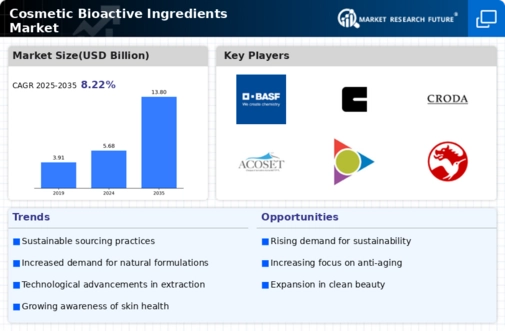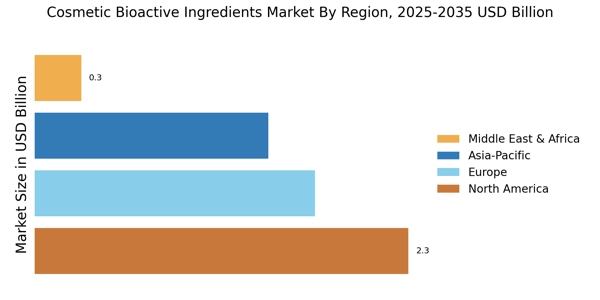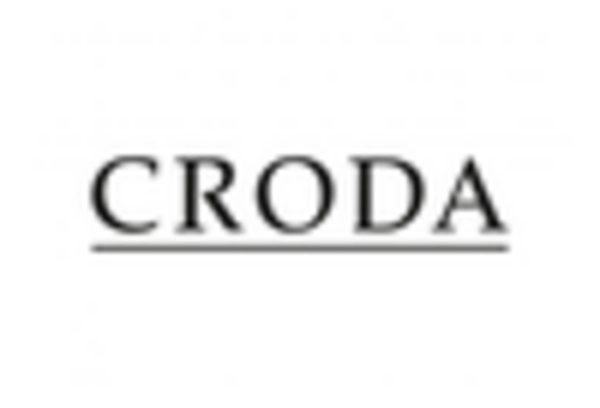Rise of Clean Beauty Trends
The clean beauty movement is significantly impacting the Cosmetic Bioactive Ingredients Market, as consumers become more discerning about the ingredients in their skincare products. This trend emphasizes transparency, safety, and the exclusion of harmful chemicals, leading to a preference for bioactive ingredients that are perceived as safer and more beneficial. Data indicates that the clean beauty segment is expanding rapidly, with consumers actively seeking products that are free from synthetic additives. This shift is prompting brands to reformulate their offerings, focusing on bioactive ingredients that meet clean beauty standards. Consequently, the Cosmetic Bioactive Ingredients Market is likely to see a proliferation of products that align with these consumer expectations.
Growing Demand for Anti-Aging Products
The Cosmetic Bioactive Ingredients Market is witnessing a notable surge in demand for anti-aging products. Consumers are increasingly seeking solutions that address skin aging, leading to a rise in formulations containing bioactive ingredients such as peptides, antioxidants, and plant extracts. According to recent data, the anti-aging segment is projected to grow at a compound annual growth rate of approximately 7% over the next five years. This trend is driven by an aging population and heightened awareness of skincare, prompting manufacturers to innovate and incorporate bioactive ingredients that promise visible results. As a result, the Cosmetic Bioactive Ingredients Market is likely to expand, with brands focusing on efficacy and consumer education to capture this growing segment.
Sustainability and Eco-Friendly Products
Sustainability has become a pivotal factor influencing consumer choices in the Cosmetic Bioactive Ingredients Market. There is a marked shift towards eco-friendly and sustainably sourced ingredients, as consumers increasingly prioritize products that align with their values. This trend is reflected in the rising popularity of organic and natural formulations, which often feature bioactive ingredients derived from renewable resources. Market data suggests that the demand for sustainable cosmetics is expected to grow significantly, with consumers willing to pay a premium for products that are environmentally responsible. Consequently, brands are adapting their strategies to incorporate sustainable practices, thereby enhancing their appeal within the Cosmetic Bioactive Ingredients Market.
Technological Innovations in Formulation
Technological advancements are playing a crucial role in the evolution of the Cosmetic Bioactive Ingredients Market. Innovations in formulation techniques, such as encapsulation and nanotechnology, are enabling the effective delivery of bioactive ingredients, enhancing their stability and efficacy. These technologies allow for the development of products that can penetrate deeper into the skin, providing more pronounced benefits. Market analysis indicates that the integration of such technologies is likely to drive growth in the sector, as consumers increasingly seek products that offer superior performance. As a result, companies are investing in research and development to leverage these advancements, positioning themselves competitively within the Cosmetic Bioactive Ingredients Market.
Increased Focus on Skin Health and Wellness
There is a growing emphasis on skin health and overall wellness within the Cosmetic Bioactive Ingredients Market. Consumers are increasingly recognizing the importance of skincare as part of a holistic approach to health, leading to a rise in demand for products that promote skin vitality and resilience. This trend is reflected in the increasing popularity of bioactive ingredients known for their health benefits, such as probiotics and vitamins. Market Research Future suggests that the wellness segment is poised for growth, as consumers seek products that not only enhance appearance but also contribute to long-term skin health. As a result, brands are likely to innovate and expand their offerings to cater to this evolving consumer mindset within the Cosmetic Bioactive Ingredients Market.


















Leave a Comment